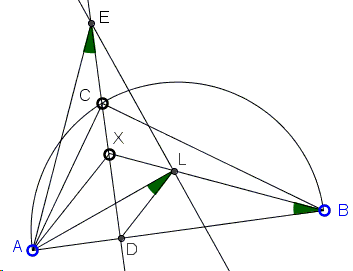A Geometry Problem from 2012 IMO - Problem 5
The applet below illustrates Problem 5 from the 2012 IMO:
Let ABC be a triangle with ∠BCA = 90°, and let D be the foot of the altitude from
C. Let X be a point in the interior of the segment CD. Let K be the point on the segment AX
such that
Show that MK = ML.
Solution
The Euclidean construction (i.e., with compass and ruler) of the problem configuration suggests a few extra elements. First of all, there is circle C(A, AC) - centered at A with radius AC - that intersects BX in L. Similarly, there is circle C(B, BC) that intersects AX in K. The altitude CD serves as the radical axis of the two circles.
The tangent to C(A, AC) at L and the tangent to C(B, BC) at K intersect in E. If we can show that E lies on the radical axis CD, the problem will be solved because then,
Let E' be the point of intersection of CD and EL. Since angles ADE' and ALE' are right, the four points A, D, L, E' are concyclic. As inscribed angles subtended by the same chord,
∠XBD = ∠LBA = ∠ALD = ∠AE'D.

It follows that the right triangles AE'D and DBX are similar, so that
(A different solution can be found at the IMO site.)
|Contact| |Front page| |Contents| |Geometry|
Copyright © 1996-2018 Alexander Bogomolny73441149
